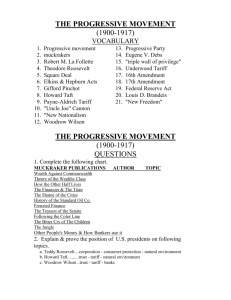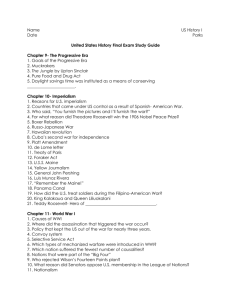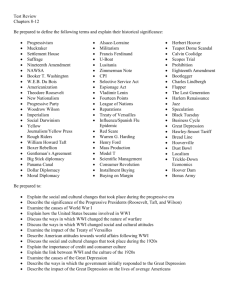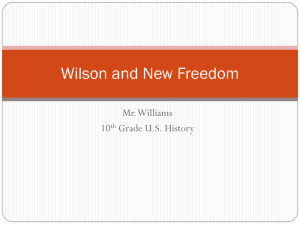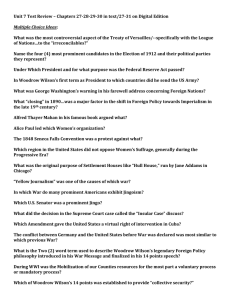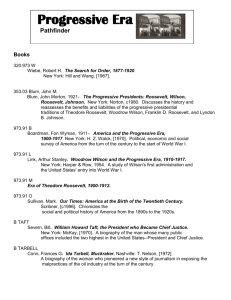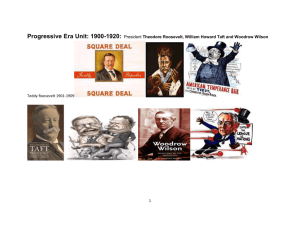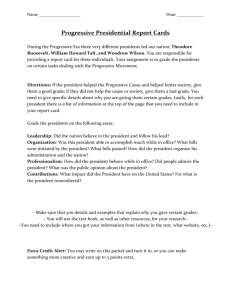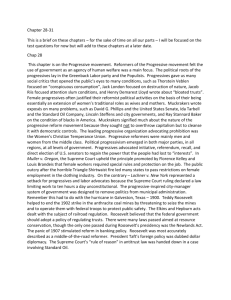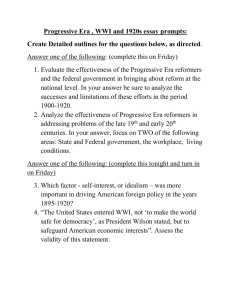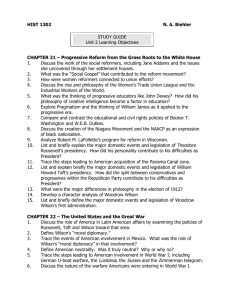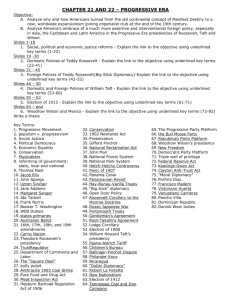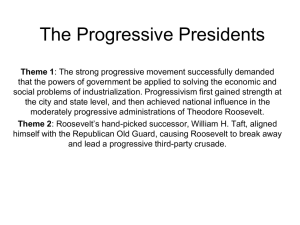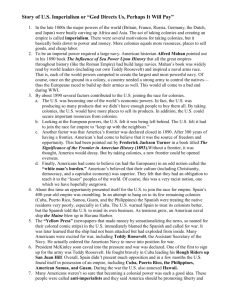Benchmark 3 - Lavergne High School
advertisement
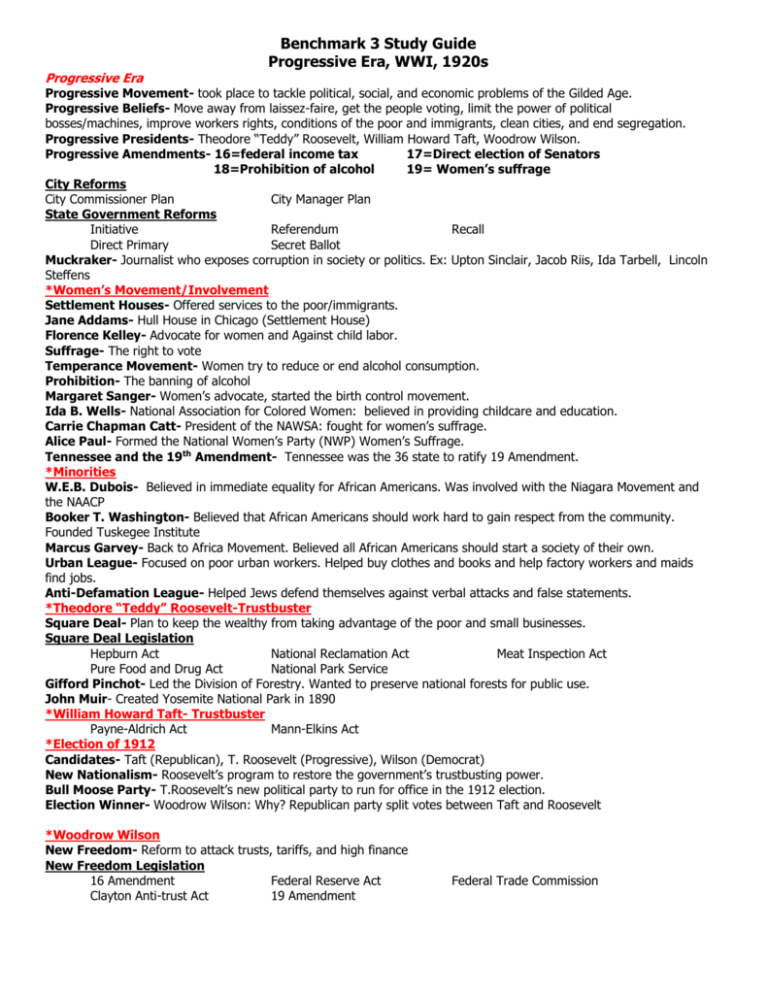
Progressive Era Benchmark 3 Study Guide Progressive Era, WWI, 1920s Progressive Movement- took place to tackle political, social, and economic problems of the Gilded Age. Progressive Beliefs- Move away from laissez-faire, get the people voting, limit the power of political bosses/machines, improve workers rights, conditions of the poor and immigrants, clean cities, and end segregation. Progressive Presidents- Theodore “Teddy” Roosevelt, William Howard Taft, Woodrow Wilson. Progressive Amendments- 16=federal income tax 17=Direct election of Senators 18=Prohibition of alcohol 19= Women’s suffrage City Reforms City Commissioner Plan City Manager Plan State Government Reforms Initiative Referendum Recall Direct Primary Secret Ballot Muckraker- Journalist who exposes corruption in society or politics. Ex: Upton Sinclair, Jacob Riis, Ida Tarbell, Lincoln Steffens *Women’s Movement/Involvement Settlement Houses- Offered services to the poor/immigrants. Jane Addams- Hull House in Chicago (Settlement House) Florence Kelley- Advocate for women and Against child labor. Suffrage- The right to vote Temperance Movement- Women try to reduce or end alcohol consumption. Prohibition- The banning of alcohol Margaret Sanger- Women’s advocate, started the birth control movement. Ida B. Wells- National Association for Colored Women: believed in providing childcare and education. Carrie Chapman Catt- President of the NAWSA: fought for women’s suffrage. Alice Paul- Formed the National Women’s Party (NWP) Women’s Suffrage. Tennessee and the 19th Amendment- Tennessee was the 36 state to ratify 19 Amendment. *Minorities W.E.B. Dubois- Believed in immediate equality for African Americans. Was involved with the Niagara Movement and the NAACP Booker T. Washington- Believed that African Americans should work hard to gain respect from the community. Founded Tuskegee Institute Marcus Garvey- Back to Africa Movement. Believed all African Americans should start a society of their own. Urban League- Focused on poor urban workers. Helped buy clothes and books and help factory workers and maids find jobs. Anti-Defamation League- Helped Jews defend themselves against verbal attacks and false statements. *Theodore “Teddy” Roosevelt-Trustbuster Square Deal- Plan to keep the wealthy from taking advantage of the poor and small businesses. Square Deal Legislation Hepburn Act National Reclamation Act Meat Inspection Act Pure Food and Drug Act National Park Service Gifford Pinchot- Led the Division of Forestry. Wanted to preserve national forests for public use. John Muir- Created Yosemite National Park in 1890 *William Howard Taft- Trustbuster Payne-Aldrich Act Mann-Elkins Act *Election of 1912 Candidates- Taft (Republican), T. Roosevelt (Progressive), Wilson (Democrat) New Nationalism- Roosevelt’s program to restore the government’s trustbusting power. Bull Moose Party- T.Roosevelt’s new political party to run for office in the 1912 election. Election Winner- Woodrow Wilson: Why? Republican party split votes between Taft and Roosevelt *Woodrow Wilson New Freedom- Reform to attack trusts, tariffs, and high finance New Freedom Legislation 16 Amendment Federal Reserve Act Clayton Anti-trust Act 19 Amendment Federal Trade Commission WWI Known as “The Great War” or “The War to end all Wars” Causes of War M ilitarism A lliances/assassination of Archduke Ferdinand I mperialism N ationalism Central Powers Germany Austria-Hungary Bulgaria Ottoman Empire Allies Russia France Great Britain Serbia U.S Italy Isolationists- Stay out of war Interventionists- U.S. should intervene on side of Allies Internationalists- Get involved only to solve the problem and promote peace New Weapons Machine guns Tanks Artillery field guns Armored Cars Poison gas Airplanes Submarines Neutrality- Not picking a side. President Wilson wanted to remain neutral with the European war. U-Boat- Submarine Reasons for U.S. Entering War- Zimmerman Note, German Submarine Warfare, Sinking of the Lusitania, unable to stay neutral Trench Warfare- Type of fighting in WWI. Soldiers dug trenches and fortified their positions. Selective Service Act- Authorized a draft for young men to serve in the war in Europe. Committee on Public Information (CPI)- Job was to send information to the public that the war in Europe was a just cause. Conscientious Objectors- People’s whose moral or religious beliefs forbid them to fight in wars. Espionage Act- Enacted severe penalties for anyone engaging in disloyal or treasonable activities. Women’s Role At Home- As men went off to war, the women started working factory jobs to send supplies to them overseas. End Of War- Armistice was signed November 11, 1918 Treaty of Versailles- created nine new nations in Europe, shifted the boundaries of others, required Germany to pay war reparations, and they were barred from maintaining an army. Weaknesses of the Treaty- 1.war-guilt clause forced Germany to admit they started the war. This would later turn to resentment for Germany and be a cause of WWII. 2.Russia lost territory that they wanted to gain back. 3.Nations in Southeast Asia were ignored for their demands for self-determination. 4. The U.S did not sign the Treaty of Versailles because Congress thought it would get the U.S. involved in conflicts we did not want to be involved in and some thought the treaty was too harsh. Fourteen Points- Wilson’s plan for plan for peace. Promoted peace without victory, declared Germany must pay war reparations (payment for war damages), open diplomacy, freedom of seas and trade, move toward ending colonialism, self-determination, and League of Nations. League of Nations- World organization where countries could peacefully resolve any issues with one another without resorting to war. The U.S did not sign the Treaty of Versailles and therefore did not join the League of Nations. This made the LON a failure from the start. Red Scare- Fear of Communism Creditor Nation- Other countries owed U.S. more money than we owed them. America came out of WWI with a new political and economic standing in the world and started to emerge as a superpower. 1920s Characteristics of 1920s- widespread social and economic change, economic prosperity, installment buying (buying on credit) and unregulated stock market Scientific Management- Ways to improve efficiency in the workplace. Assembly line- Henry Ford used this to put together his MODEL T. Consumer Revolution- New affordable goods became available to the public, so the public bought them. Most people bought these thing by using credit. Warren G. Harding- Elected President in 1920. Ohio Gang- Harding’s group of close friends that made decisions for him. Teapot Dome Scandal- Secretary of the Interior Albert Fall took bribes to transfer control of oil reserves from the U.S. Navy to private oilmen. Calvin Coolidge- Became President in 1923 with the death of Harding Kellogg-Briand Pact- To outlaw war as an instrument of national policy. Quota laws- set limits on how many immigrants could come to America from certain countries. Prohibition- The banning of alcohol Effects of Prohibition- increase in organized crime (Al Capone), bootlegging, speakeasies Scopes “Monkey” Trial- 1925 Dayton, TN. High School teacher John Scopes taught evolution in his classroom. (It was illegal to teach evolution on TN schools) The incident went to trial. Clarence Darrow defended Scopes at trial. William Jennings Bryan served as an expert on the Bible for the prosecution. Scopes was found guilty of breaking the law and fined $100. Mass Culture Flapper- Revolutionary woman of 1920s. Characterized by short skirts, makeup, bob hair cut Charlie Chaplin- Silent film star The Jazz Singer- First movie with sound Charles Lindbergh- Flew the Spirit of St. Louis. First to fly across the Atlantic Ocean. New York to Paris, France Sigmund Freud- Psychologist thought that much of human behavior is driven by unconscious desires. “Lost Generation”- Writers of the 1920s who were characterized by disillusion with WWI and a search for a new sense of meaning. F. Scott Fitzgerald- Wrote The Great Gatsby, This Side of Paradise Ernest Hemmingway - Wrote A Farwell To Arms William Faulkner- Wrote The Sound and the Fury Sport Heroes Babe Ruth- Baseball Jack Dempsey- Boxing Red Grange- Football Bobby Jones- Golf Bill Tilden- Tennis Helen Willis- Tennis Gertrude Ederle- Swimming Harlem Renaissance Characteristics of the Harlem Renaissance- Jazz music, literary and artistic achievement by African Americans Jazz Musicians Louis Armstrong Bessie Smith Literature Claude McKay Langston Hughes Zora Neal Hurston
